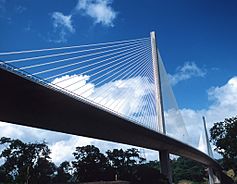Centennial Bridge, Panama facts for kids
Quick facts for kids Centennial Bridge |
|
|---|---|
 |
|
| Coordinates | 9°1′48.19″N 79°38′8.47″W / 9.0300528°N 79.6356861°W |
| Carries | 6 lanes of the Pan-American Highway |
| Crosses | Culebra Cut of the Panama Canal |
| Locale | Panama |
| Official name | Puente Centenario |
| Characteristics | |
| Design | Cable-stayed bridge |
| Total length | 1,052 m (3,451 ft) |
| Longest span | 420 metres (1,380 ft) |
| Clearance below | 80 m (260 ft) |
| History | |
| Construction cost | $120 million USD |
| Opened | 15 August 2004 |
The Centennial Bridge (in Spanish, Puente Centenario) is a very important bridge in Panama. It crosses the famous Panama Canal. This bridge was built because the older Bridge of the Americas was getting too crowded. It also became the new main path for the Pan-American Highway across the canal. When it opened in 2004, it was only the second permanent bridge to cross the canal.
Contents
What is the Centennial Bridge?
The Centennial Bridge is the second big road crossing over the Panama Canal. The first one was the Bridge of the Americas. (There are also smaller bridges at the canal locks, but these are only for service and have limited use.)
The Centennial Bridge is located about 15 kilometers (9 miles) north of the Bridge of the Americas. It crosses a part of the canal called the Culebra Cut (also known as Gaillard Cut), near the Pedro Miguel locks. New highways were built to connect the bridge from Arraijan in the west to Cerro Patacon in the east. These new roads and the bridge have greatly helped to reduce traffic jams on the Bridge of the Americas.
History of the Bridge
The Bridge of the Americas, which opened in 1962, used to be the only major road crossing over the Panama Canal. When it first opened, about 9,500 vehicles used it every day. However, by 2004, this number had grown to 35,000 vehicles daily.
Because the old bridge was becoming a major traffic bottleneck on the Pan-American Highway, Panama's Ministry of Public Works asked companies to bid on building a second canal crossing in October 2000. The contract to build this new bridge was given out in March 2002.
The builders had a very ambitious goal: to finish the bridge in just 29 months. This was so it could open on the 90th anniversary of the first ship passing through the Panama Canal. That first ship was the cargo ship Ancon, which sailed through on August 15, 1914. The bridge was named to celebrate Panama's centennial (100th anniversary), which happened on November 3, 2003.
The new bridge was designed by a team from T.Y. Lin International and the Louis Berger Group Inc. It was built by a German company called Bilfinger Berger Ingenieurbau GmbH. The bridge was officially opened on August 15, 2004, right on schedule. However, it was opened for traffic later, on September 2, 2005, after the new highways leading to it were fully completed.
In December 2010, a part of the road leading to the Centennial Bridge collapsed because of heavy rain and flooding. Full traffic was restored on the bridge in November 2011.
How the Bridge was Built
The Centennial Bridge is a cable-stayed design. This means it has cables that connect the bridge deck to tall towers, holding it up. The total length of the bridge is 1,052 meters (3,451 feet). The main part of the bridge, which crosses directly over the canal, is 420 meters (1,378 feet) long. It stands 80 meters (262 feet) above the canal, which is high enough for even very large ships to pass underneath.
The bridge is supported by two tall towers, each 184 meters (604 feet) high. The bridge deck has six lanes for traffic to cross the canal.
The Centennial Bridge was designed to be strong enough to withstand earthquakes, which happen often in the canal area. The German construction company Bilfinger built it.
The West Tower of the bridge was built about 50 meters (164 feet) inland from the canal. This was done to leave space for the Panama Canal to be widened in the future.
Awards for the Bridge
The Centennial Bridge has received some special awards:
- 2005 Bridge Award of Excellence, from the American Segmental Bridge Institute (ASBI).
- 2007 Merit Award, from the Consulting Engineers and Land Surveyors of California (CELSOC).
Images for kids
Gallery
See also
 In Spanish: Puente Centenario (Panamá) para niños
In Spanish: Puente Centenario (Panamá) para niños
- List of bridges in Panama



